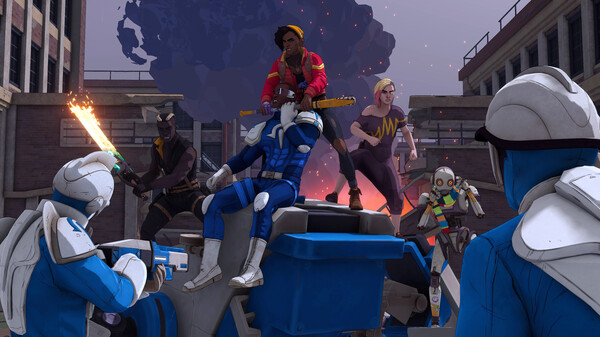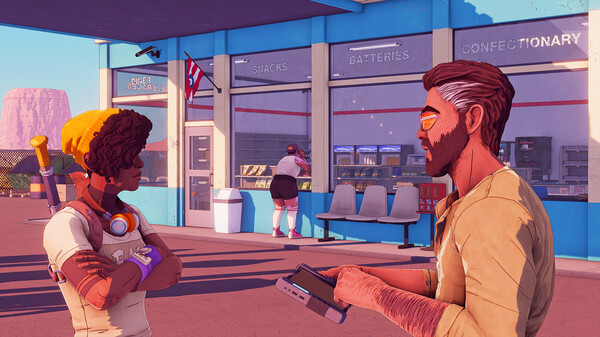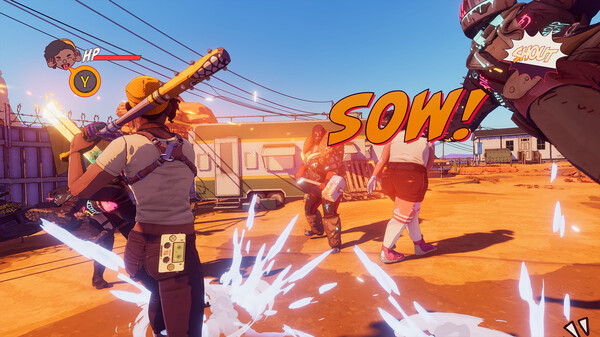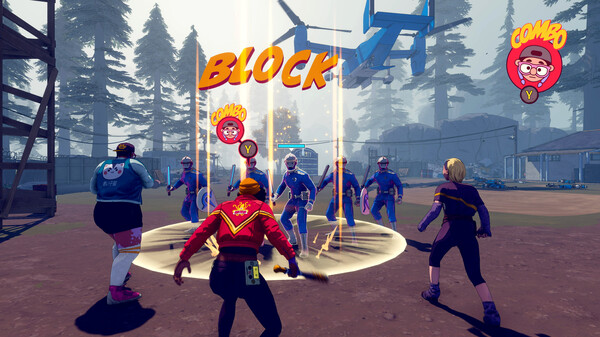Dustborn Review (PS5)
Summary: Rock and roll with the indifferent, outcasted, and unwanted miscreants born from the dust! Words have power (literally) in this narrative based adventure across a broken country that houses unimaginable secrets. Even if the game suffers from poor design decisions and bad gameplay mechanics, there's no way to gaslight it's original take on the genre that expresses a sentiment no word can fully capture.
3.4
Symbolic Memes
The people on the bus go up and down during this rocky road trip across the country in search for a better life. Dustborn is a story-driven action-adventure game developed by Red Thread Games, published by Quantic Dream, and released on August 20th of 2024. Dustborn is a narrative based game similar to the Life Is Strange series by Don’t Nod and Deck Nine or the Telltale Games like The Wolf Among Us and The Walking Dead where the game is driven by your actions with other characters as well as your decisions that move the story forward. Much of Dustborn deals with you juggling the emotional quandaries of your companions while dealing with the impending pressure of important story commitments. Dustborn has evolved this genre by adding more of a natural flow between gameplay and conversations in addition to combat which is a daring mix with the heavy weighted branching narrative beats. While this step in a new direction is much appreciated and makes Dustborn unique and enjoyable in its own right, there are also decisions and odd contrivances that ruin this world tour.
The story in Dustborn sees four characters on the run from the law with something valuable in tow. Pax, the protagonist and professional con artist, and her group of criminals have crucial information that they stole from such a high power that they are continuously being hunted by the police force. Their goal is to make it across an alternate history version of the country, The Divided States of America, out of Pacifica to Nova Scotia where they will be free. The makeshift family create a cover-up story of being a touring band to “safely” make it through district checkpoints and be concealed from the prying eyes of thugs and cops. The gang have anything but safe travels as they constantly find themselves in awkward dilemmas that cut their fun times short and entangling mysteries that question the purpose of their journey.
Dustborn starts off really slow, but cranks the intrigue up to 11 within a few of the game’s “episodes”. It feels like the drive of the story is going one way, but immediately makes a sharp turn away from expectation street and conventional avenue. The game’s twists and shocking moments will have you rethinking your decision making and the lore and world building is fleshed out and begs to be devoured with its rich characters, interesting abilities, and colorful landscapes. The game is incredibly political, especially given the subtext of this alternate history we are playing in which coincides with the themes and backstories of the characters. Sometimes the subject manner is so cherry picked that it feels too ham-fisted and unnecessary to bring up; so much so that it careens the main topic off track by how obscure it is randomly brought up just to mention it and brushed aside for no reason. Nonetheless, the story, narrative structure, and written scripts between characters is Dustborn’s strong suit and easily keeps you invested in this long and complicated pilgrimage.
Gameplay is simple, but effective when it comes to talking and the relationship between your bus mates, but controlling Pax in and out of combat is clunky. Exploring the environments is fun and there’s a lot of interactivity with your surroundings through picking up objects and gifting them to your friends, tracking down ghost like entities to level up your powers, finding electrical components to upgrade your bat weapon, and simply figuring out the world and how you fit in it. You have choices that you can make that affect your teammates in different ways that will send them down one of a few branching paths which in turn sways their opinions and decisions in particular situations that may help or hurt you later down the road. Changing a character’s mind in one situation may help you get what you want, but that may change their beliefs or they may not see you as the type to take charge so you may not be able to use them the way you want to later on. The intense state of affairs and indecisive conditions is what makes these types of games fascinating and Dustborn does a great job of keeping you on your toes and relishes in its ambiguous moments that make you hesitate.
Some characters in the world of Dustborn are known as Anomals, people that wield their words as a power that can directly affect someone else. Pax can use these Vox abilities during combat to hinder, disable, and weaken her opponents. Landing hits on enemies will build up your Vox meter and when it is filled, you can use one of your known words to give you an advantage. You can rally up your comrades and buff your attacks, push the enemies back in a wild rag doll fashion, and make them believe that they are on fire. You also have a taunt attack that slowly builds over time and acts as a powerful rush move when activated which is not only good for the free damage that comes out of it, but can be used strategically to quickly get out of the way of another enemy’s attack. Pax can also dodge and you can unleash some fancy team attacks to cause even more destruction.
The combat in Dustborn is inventive and there was definitely some thought into making the powers engrossing in this way, but overall, the gameplay during the fighting segments is strikingly lackluster. It immediately feels off and the controls are not tight enough to make anything feel snappy or substantial. Your attacks never feel impactful and often you are just running around aimlessly in the combat arena awkwardly trying to pull off one of your Vox moves or repeatedly hitting the attack button to execute the one boring combo. The blocking feels weak and usually makes you face the opposite direction that you want to be facing. While the combat gets the job done, that’s all it does. It’s sort of disappointing for how original and fleshed out the narrative is, the combat couldn’t be just as good; especially for how imaginative it is already.
Graphically, Dustborn is artistically amazing by having a vivid comic book style. This perspective is beautiful and the skillful approach isn’t just a gimmick. The story is told as if it were pages in a comic. Pax’s thoughts are written across the top in a comic sans format and characters’ emotions are expressed over their heads whether it be beads of sweat if they are worried or embarrassed or bubbling question marks if they are confused. Pausing the game will show a torn page with all of the dialogue that just happened that you can scroll through if you missed something. The world is bright and colorful and each character has their own signature look that pops. Dustborn looks impressive and the cool polish with its graphics makes each rest stop an exciting journey to see what’s around the next corner.
Even though the game looks great, I did run into an abundance of graphical issues. Characters would roughly pop in the next spot they were supposed to be in. Pop-in happened often with objects such as rocks, clouds, and entire rooms. You can funnily place yourself on things that you are not supposed to be on top of and walk through solid objects. Items will disappear like an entire grill leaving the eggs sunny side up in midair. The color of boxes would flash between brown and pink for no reason. Large set pieces like swinging gates would just randomly go missing after a cutscene. While these issues were persistent and were a dime a dozen throughout my entire playthrough, they never broke the immersion or ruined my fun of actually playing through the game.
Dustborn’s soundtrack is filled with passion and blankets each situation accordingly. Moments of stealth are accompanied by music that fills the air with suspenseful energy and somber tunes played during serious talks between friends. I discerned the difference of the pitter-patter of your feet on different mediums to be quite noticeable as well; the swash of water in particular is quite effective. The main cast of characters are all voiced wonderfully and project their thoughts and beliefs realistically. A lot of the jokes even land well due to the great voice acting.
While that’s all good and well, unfortunately there are a lot of bad audio designs. There seems to be thresholds at certain points where music would stop completely causing superficial moments during gameplay. Characters talk way too much and oftentimes talk over each other and interrupt each other, making you miss out on crucial information as well as just being an annoying amalgamation to your ears. Characters even talk while you fight, but again, there is way too much dialogue. Conversations last the entire combat session and you can’t even focus on what they are saying due to the conversations being drowned out by the music and the fighting.
Frequently, you will run into situations where the characters will repeat what they said so you don’t miss out on something, but again the threshold when this happens is askew so many times it will seem like every character you run by is stuttering or fumbling over their words. The delivery for NPCs is all over the place and the sound quality for some lines will randomly take a huge dip. Sometimes someone will be too loud and other times someone may sound too muffled. Characters’ alternate dialogue would also go off too soon at points so after you would be done talking to someone, they will say a line to let you know that you have exhausted all of their dialogue options, but then immediately after they will say the same thing, but in a different way.
There are misspelled words in the subtitles and sometimes entire character scripts are handled and delivered inaccurately. In my playthrough, a character talks to someone on a payphone while the music swells in a sorrowful way. I made it to the end of this section and was wrapping that particular area up when the character’s dialogue and the sad music started playing again when I walked near the payphone. The camera also whipped all the way around to show the character that was supposed to be talking on the other side of the map as if this event hadn’t already happened. Another messy circumstance I found myself in is that I came to a situation where you can choose one of two things. After picking one, the characters continuously talked as if I had picked the other option. Mistakes like this in story based adventures where the crux of the game is based purely off of your decision making can be exasperating.
Final Thoughts?
Dustborn is definitely a game that is unparalleled. It does a lot of extreme things that are new to this particular style of story based games and while a lot of what it does ends on a sour note, it should still be recognized for trying something different. Whether you’re a fan of certain aspects of the game or not, the overarching plot remains riveting all the way through. Even though the combat mechanics were executed poorly, it bestows its creativeness and originality to the genre gracefully. The excellent world building and voice acting make Dustborn an exciting ride that you never want to get off of. Take this expedition with this motley crew of devious rule breakers into the unknown for the sake of belonging and justice.



















